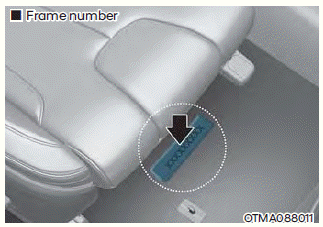Hyundai Santa Fe: Automatic climate control system / System operation
Ventilation
1. Set the mode to the .png) position.
position.
2. Set the air intake control to the outside (fresh) air position.
3. Set the temperature control to the desired position.
4. Set the fan speed control to the desired speed.
Heating
1. Set the mode to the .png) position.
position.
2. Set the air intake control to the outside (fresh) air position.
3. Set the temperature control to the desired position.
4. Set the fan speed control to the desired speed.
5. If dehumidified heating is desired, turn the air conditioning system on. If
the windshield fogs up, set the mode to the
.png) or
or
.png) position.
position.
Operation Tips
- To help keep dust or unpleasant fumes from entering the vehicle through the ventilation system, temporarily set the air intake control to the recirculated air position. Be sure to return the control to the fresh air position when the irritation has passed to keep fresh air in the vehicle. This will help keep the driver alert and comfortable.
- To prevent interior fog on the windshield, set the air intake control to the fresh air position and fan speed to the desired position, turn on the air conditioning system, and adjust the temperature control to the desired temperature.
Air conditioning
HYUNDAI Air Conditioning Systems are filled with R-1234yf refrigerant.
1. Start the engine. Push the air conditioning button.
2. Set the mode to the .png) position.
position.
3. Set the air intake control to the outside air or recirculated air position.
4. Adjust the fan speed control and temperature control to maintain maximum comfort.
NOTICE
When using the air conditioning system, monitor the temperature gauge closely while driving up hills or in heavy traffic when outside temperatures are high. Air conditioning system operation may cause engine overheating. Continue to use the fan but turn the air conditioning system off if the temperature gauge indicates engine overheating.
Air conditioning system operation tips
- If the vehicle has been parked in direct sunlight during hot weather, open the windows for a short time to let the hot air inside the vehicle escape.
- After sufficient cooling has been achieved, switch back from the recirculated air to the fresh outside air position.
- To help reduce moisture inside of the windows on rainy or humid days, decrease the humidity inside the vehicle by operating the air conditioning system with the windows and sunroof closed.
- Use the air conditioning system every month for a few minutes to ensure maximum system performance.
- If you operate the air conditioner excessively, the difference between
the temperature of the outside air and that of the windshield could cause the
outer surface of the windshield to fog up, causing loss of visibility. In this
case, set the mode selection button to the
.png) position and set the fan speed
control knob to the lowest speed setting.
position and set the fan speed
control knob to the lowest speed setting.
 Fan speed control. Air conditioning. OFF mode
Fan speed control. Air conditioning. OFF mode
Fan speed control
The fan speed can be set as desired by pushing the fan speed control button.
More air is delivered with higher fan speeds.
Pressing the OFF button turns off the fan...
 System maintenance
System maintenance
Cabin air filter
[A] : Outside air, [B] : Recirculated air, [C] : Cabin air filter, [D] : Blower,
[E] : Evaporator core, [F] : Heater core
The cabin air filter is installed behind the glove box...
Other information:
Hyundai Santa Fe (TM) 2019-2025 Service Manual: Rear Washer Switch. Repair procedures
Inspection 1. Check for continuity between the terminals in each switch position as shown below. Switch Switch position Switch terminal Resistance (Ω, ±3...
Hyundai Santa Fe (TM) 2019-2025 Service Manual: Emergency Call (eCall) Antenna. Repair procedures
Removal eCall Antenna 1. Disconnect the negative (-) battery terminal. 2. Remove the roof trim assembly. (Refer to Body - "Roof Trim Assembly") 3...
Categories
- Manuals Home
- 4th Generation Santa Fe Owners Manual
- 4th Generation Santa Fe Service Manual
- System settings
- Troubleshooting
- Child-protector rear door locks
- New on site
- Most important about car
Vehicle Identification Number (VIN). Vehicle certification label. Tire specification and pressure label
Vehicle Identification Number (VIN)

The vehicle identification number (VIN) is the number used in registering your vehicle and in all legal matters pertaining to its ownership, etc.
The number is punched on the floor under the passenger seat. To check the number, open the cover.
